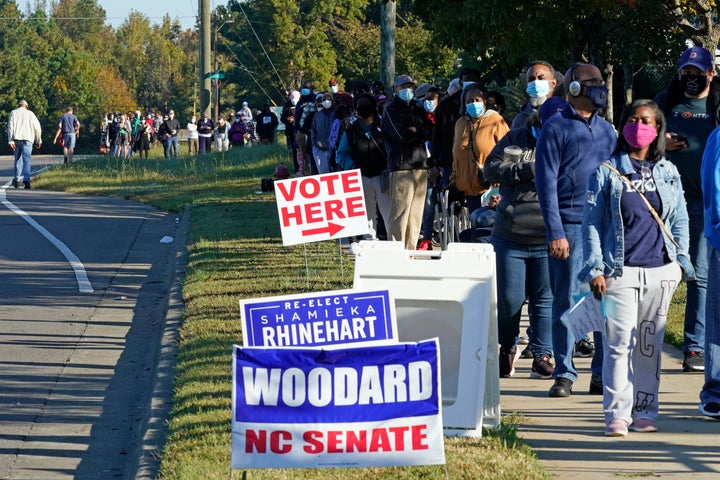Long lines wrap around blocks in Georgia, North Carolina and Texas. Election clerks receive a flood of absentee ballots earlier and in higher volume in states like Florida, New Jersey and Wisconsin. Americans are voting early in record numbers this year, and this is what it looks like.
As of Oct. 15, more than 17 million people have already cast their ballots in the 2020 election, according to the U.S. Elections Project. That would total 12% of the 138 million Americans who voted in 2016. But most election experts anticipate record voter turnout in this election year.
This flood of ballots will quickly turn into a tsunami as American voters possibly turn out at the highest rate since 18-20-year-olds got the right to vote in 1971.
“It’s just very different from any other presidential election that any of us have witnessed,” said Barry Burden, director of the Elections Research Center at the University of Wisconsin-Madison. “There are several forces coming together to make this happen.”
The record early voter turnout is not just a reaction to the coronavirus pandemic, but a result of a confluence of events.
First, election experts predicted in 2019 that there would be high turnout as voters paid an unprecedented amount of attention to the election so early in the election calendar. Catalist, a Democratic Party voter data firm, predicted in a 2019 paper that there would be “another historic level of turnout” in 2020 after 2018’s record midterm election turnout. The conservative pollster Public Opinion Strategies warned Republicans in a 2019 PowerPoint presentation of “upcoming record turnout” that would be far more diverse than in past elections.

Second, voters also have relatively fixed views on at least one of the presidential candidates: President Donald Trump. He has been the most consistently unpopular president in polling history and has maintained record high rates of strong disapproval throughout his four years in office. Voters who want him out really want him out.
And third, the coronavirus pandemic triggered almost every state to allow for no-excuse absentee voting. Three states — California, Nevada and New Jersey — and the District of Columbia decided to conduct their elections almost entirely through the mail; joining the five states that already held all-mail elections.
Voters have been urged to vote absentee or early to help reduce crowding at the polls on Election Day and thereby decrease the potential spread of the coronavirus. And many voters either experienced or heard about issues during their state’s primary elections this year or Postal Service delays and want to vote as early as possible to avoid any problems.
These three trends combine to form the early voting wave sweeping the country.
Already, six states ― California, Florida, Michigan, New Jersey, Texas and Virginia ― have recorded more than 1 million votes cast. Georgia is close on their heels with more than 900,000 ballots cast. North Carolina will also likely vault into the million-plus early vote club as its early in-person voting period began on Thursday. Thirteen states have already recorded more than 20% of their entire 2016 vote total.
“If the trend we’re seeing yesterday and today holds up throughout early voting, Texas is going to see higher turnout than we’ve seen in a very long time,” Anthony Gutierrez, executive director of the open government and voting rights organization Common Cause Texas, said on Wednesday.
In states that report the party affiliations of those returning their ballots early, registered Democrats are both requesting and returning their ballots at far higher rates than registered Republicans. This tracks with public polling showing that Democrats are far more likely to cast absentee ballots due to the pandemic, while Republicans plan to vote in person on Election Day. Republican partisans are likely responding to Trump’s disinformation campaign falsely claiming that voting by mail is ripe for fraud.
The record early voting has also caused predictable problems, although nothing out of the ordinary. Long lines at early voting sites may be a reflection of COVID-19 social distancing regulations, or they could reveal poor planning by election officials, poor training of election workers or understaffing.
In Georgia, massive lines snaked out of early voting sites in metro Atlanta region counties, leading to waits that exceeded nine hours for some voters. The state’s Republican secretary of state blamed the waits on record turnout, and it is true that the first days of early voting in most states produce high-volume turnout. But the problem turned out to be a faulty computer system that could not handle the volume of voters, according to the Atlanta Journal-Constitution.
Other problems emerged across Georgia that have become “systemic to Georgia,” said Aunna Davis, executive director of Common Cause Georgia, including “machines not working and poll workers not knowing how to use new technology.” Voters were also not able to obtain emergency paper ballots in some locations with faulty machines.
These are the types of problems voters will likely face in many early voting states. Malfunctioning machines, poor training and poll worker shortages can lead to major backups. They are the typical types of problems that emerge from America’s underfunded and decentralized election system. And they disproportionately affect Black and Latino communities.
Some counties sought to tackle these problems early to make it easier for voters to cast their ballots freely and safely. For example, election officials in Harris County, the most populous county in Texas and the home of its most populous city, Houston, increased their early voting sites from 40 in 2016 to 122 this year. A handful of these sites operate 24 hours a day, allowing shift workers an opportunity to cast their ballots at a time convenient for them. The county has already seen a record of more than 100,000 residents cast their ballots in the first two days of early voting.
But there are some problems created solely by partisan politics. For example, Texas Gov. Greg Abbott (R) limited the number of drop-off locations for absentee ballots to one per county in an executive order issued on Oct. 1. The order forced Harris County to close 11 drop-off locations and caused unnecessarily long lines at the single remaining drop-off location. This problem was exacerbated by Trump’s Postal Service head enacting reforms that dramatically slowed mail delivery.
“That is something that a lot of people are concerned about,” Gutierrez said.

